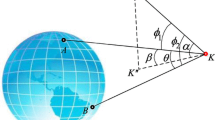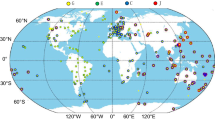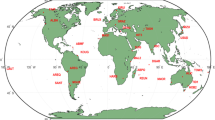Abstract
Due to the rapid deployment of the Galileo constellation, Galileo is now able to contribute to GNSS precise point positioning (PPP) ambiguity resolution (AR) with 17 operational satellites as of December 2017. We estimate the satellite fractional cycle bias (FCB) based on globally distributed MGEX stations and assess the Galileo FCB quality by a comparison with that of GPS and BDS. Results of 60 days indicate that the quality of Galileo wide-lane (WL) FCB is better than GPS and BDS in terms of data usage rate, residual distribution, as well as standard deviation of daily estimates. The RMS of Galileo WL FCB residuals is 0.071 cycles, while that of GPS and BDS are 0.089 and 0.117 cycles, respectively. The standard deviation of Galileo daily WL FCB is 0.010 cycles, while that of GPS and BDS is 0.018 and 0.043 cycles. We attribute the better quality of Galileo WL FCB to its signal modulation, AltBOC, which significantly compresses the multipath effect for pseudorange measurement. Within the Galileo constellation, the performance of In-Orbit Validation (IOV) satellites WL FCB is worse than that of Full Operational Capability (FOC) satellites as a result of a reduction in the power of the transmitted signal. The performance of the two highly eccentric satellites is comparable to other FOC satellites. The overall quality of Galileo narrow-lane (NL) FCB is slightly worse than that of GPS but better than that of BDS. The RMS of Galileo NL FCB residuals is 0.062 cycles, while that for GPS and BDS is 0.050 and 0.086 cycles respectively. In addition, the NL FCB quality of FOC, IOV (except E19), as well as the two eccentric satellites, shows no significant difference in terms of data usage rates and residuals. Galileo PPP AR solutions are conducted at 20 MGEX stations with 3-h sessions for 10 days. The positional biases of AR solutions are 0.7, 0.6, and 2.1 cm for east, north and up components respectively, while those for float solutions are 2.1, 1.1, and 2.7 cm, corresponding to the improvements of 67, 45, and 22%, respectively. These results demonstrate that, currently, Galileo FCB can be estimated with accuracy comparable with GPS and BDS, and the Galileo observations can bring an obvious benefit to ambiguity-fixed PPP.


















Similar content being viewed by others
References
Collins P, Lahaye F, Héroux P, Bisnath S (2008) Precise point positioning with ambiguity resolution using the decoupled clock model. In: Proceedings of the ION GNSS 2008, Institute of Navigation, Savannah, Georgia, September 16–19 2008. pp 1315–1322
Ge M, Gendt G, Rothacher M, Shi C, Liu J (2008) Resolution of GPS carrier-phase ambiguities in precise point positioning (PPP) with daily observations. J Geodesy 82(7):389–399
Geng J, Shi C (2016) Rapid initialization of real-time PPP by resolving undifferenced GPS and GLONASS ambiguities simultaneously. J Geodesy 91(4):361–374
Geng J, Meng X, Dodson AH, Teferle FN (2010) Integer ambiguity resolution in precise point positioning: method comparison. J Geodesy 84(9):569–581
Gu S, Lou Y, Shi C, Liu J (2015) BeiDou phase bias estimation and its application in precise point positioning with triple-frequency observable. J Geodesy 89(10):979–979
Guo F, Li X, Zhang X, Wang J (2017) Assessment of precise orbit and clock products for Galileo, BeiDou, and QZSS from IGS multi-GNSS experiment (MGEX). GPS Solut 21(1):279–290
Hatch R (1982) The synergism of GPS code and carrier measurements. In: Proceedings of the 3rd international symposium on satellite doppler positioning at Physical Sciences Laboratory of New Mexico State University, February 8–12, pp 1213–1231
Laurichesse D, Mercier F, Berthias J-P, Broca P, Cerri L (2009) Integer ambiguity resolution on undifferenced GPS phase measurements and its application to PPP and satellite precise orbit determination. Navigation 56(2):135–149
Li X, Zhang X (2012) Improving the estimation of uncalibrated fractional phase offsets for PPP ambiguity resolution. J Navig 65(3):513–529
Li P, Zhang X (2015) Precise point positioning with partial ambiguity fixing. Sensors 15(6):13627–13643
Li P, Zhang X, Ren X, Zuo X, Pan Y (2015) Generating GPS satellite fractional cycle bias for ambiguity-fixed precise point positioning. GPS Solut 20(4):771–782
Li P, Zhang X, Guo F (2017a) Ambiguity resolved precise point positioning with GPS and BeiDou. J Geodesy 91(1):25–40
Li X, Li X, Yuan Y, Zhang K, Zhang X, Wickert J (2017b) Multi-GNSS phase delay estimation and PPP ambiguity resolution: GPS, BDS, GLONASS, Galileo. J Geodesy 92(6):579–608
Liu Y, Ye S, Song W, Lou Y, Gu S (2017) Rapid PPP ambiguity resolution using GPS + GLONASS observations. J Geodesy 91(4):441–455
Loyer S, Perosanz F, Mercier F, Capdeville H, Marty J-C (2012) Zero-difference GPS ambiguity resolution at CNES-CLS IGS analysis center. J Geodesy 86(11):991–1003
Melbourne WG (1985) The case for ranging in GPS-based geodetic systems. In: Proceedings of the first international symposium on precise positioning with the Global Positioning System, Rockville, 1985. pp 373–386
Montenbruck O et al (2017) The multi-GNSS experiment (MGEX) of the international GNSS service (IGS)—achievements, prospects and challenges. Adv Space Res 59(7):1671–1697
Prange L, Orliac E, Dach R, Arnold D, Beutler G, Schaer S, Jäggi A (2017) CODE’s five-system orbit and clock solution—the challenges of multi-GNSS data analysis. J Geodesy 91(4):345–360
Shi J, Gao Y (2014) A comparison of three PPP integer ambiguity resolution methods. GPS Solut 18(4):519–528
Sonica K, Prange L, Kamierski K, Bury G, Drodewski M, Zajdel R, Hadas T (2017) Validation of Galileo orbits using SLR with a focus on satellites launched into incorrect orbital planes. J Geodesy 92(2):131–148
Takasu T, Yasuda (2010) A Kalman-filter-based integer ambiguity resolution strategy for long-baseline RTK with ionosphere and troposphere estimation. In: ION NTM 2010. pp 161–171
Tegedor J, Liu X, Jong K, Goode M, Øvstedal O, Vigen E (2016) Estimation of Galileo uncalibrated hardware delays for ambiguity-fixed precise point positioning. Navigation 63(2):173–179
Teunissen PJG, Khodabandeh A (2015) Review and principles of PPP-RTK methods. J Geodesy 89(3):217–240
Teunissen PJG, Jonge PJ, Tiberius CCJM (1997) Performance of the LAMBDA method for fast GPS ambiguity resolution. Navigation 44(3):373–383
Teunissen PJG, Joosten P, Tiberius CCJM (1999) Geometry-free ambiguity success rates in case of partial fixing. In: Proceedings of the 1999 national technical meeting of the institute of navigation. San Diego, CA, pp 201–207
Uhlemann M, Gendt G, Ramatschi M, Deng Z (2016) GFZ global multi-GNSS network and data processing results. Springer, New York
Wang M, Chai H, Li Y (2017) Performance analysis of BDS/GPS precise point positioning with undifferenced ambiguity resolution. Adv Space Res 60(12):2581–2595
Wanninger L, Beer S (2015) BeiDou satellite-induced code pseudorange variations: diagnosis and therapy. GPS Solut 19(4):639–648
Wübbena G (1985) Software developments for geodetic positioning with GPS using TI-4100 code and carrier measurements. In: Proceedings of the 1st international symposium on precise positioning with the global positioning system, Rockville, 1985. pp 403–412
**ao G, Sui L, Heck B, Zeng T, Tian Y (2018) Estimating satellite phase fractional cycle biases based on Kalman filter. GPS Solut 22(3):82. https://doi.org/10.1007/s10291-018-0749-3
Yi W et al (2017) Improved method to estimate undifferenced satellite fractional cycle biases using network observations to support PPP ambiguity resolution. GPS Solut 21(3):1369–1378
Zaminpardaz S, Teunissen PJG (2017) Analysis of Galileo IOV + FOC signals and E5 RTK performance. GPS Solut 21(4):1855–1870
Acknowledgements
Thanks go to IGS-MGEX and GFZ for providing GNSS data and products. Thanks also go to Maorong Ge from GFZ for valuable discussions. Guorui **, Zhengzhou, 450052, China
Corresponding author
Rights and permissions
About this article
Cite this article
**ao, G., Li, P., Sui, L. et al. Estimating and assessing Galileo satellite fractional cycle bias for PPP ambiguity resolution. GPS Solut 23, 3 (2019). https://doi.org/10.1007/s10291-018-0793-z
Received:
Accepted:
Published:
DOI: https://doi.org/10.1007/s10291-018-0793-z




